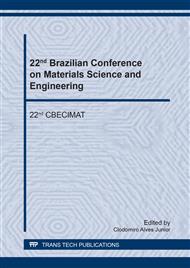p.445
p.449
p.454
p.460
p.466
p.472
p.478
p.484
p.489
Influence of Thickness on Magnetic and Microstructural Properties in Electrical Steels Semi-Processed of Low Efficiency
Abstract:
In this study, a steel for semiprocessed electrical purposes of non-oriented grain with approximately 0.05% carbon content and 0.02% silicon content was evaluated. Lamellas with kind of thicknesses 0.58 mm, 0,66 mm and 0.87 mm were processed on an industrial scale with a strain rate in the hardening lamination between 3 and 5%. The magnetic properties were evaluated after the wet heat treatment. The loss separation method was applied, estimating the hysteretic plot with hysteresis measure in the quasi static condition and the parasitic losses calculated according to Thomson's Equation. By increasing grain size, permeability increases and coercivity decreases. However, in the case of losses, there is an optimum grain size. After the procedure of separation of losses, it was observed that increase of thickness results in increase of the anomalous parcel of magnetic losses.
Info:
Periodical:
Pages:
466-471
Citation:
Online since:
September 2018
Price:
Сopyright:
© 2018 Trans Tech Publications Ltd. All Rights Reserved
Share:
Citation:


